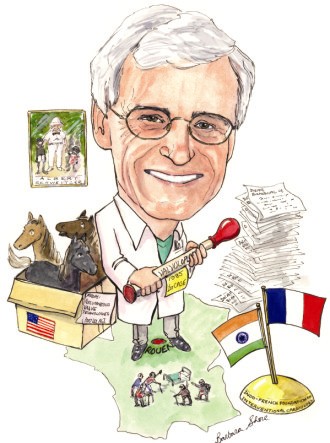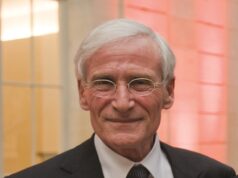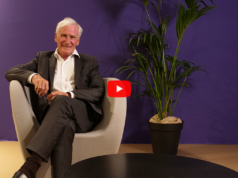 Professor Alain Cribier is a pioneer in the field of aortic and mitral valvuloplasty and has been responsible for a number of world firsts, including last year the first human case of percutaneous valve replacement in aortic stenosis. He talked to Cardiovascular News about his career and procedures.
Professor Alain Cribier is a pioneer in the field of aortic and mitral valvuloplasty and has been responsible for a number of world firsts, including last year the first human case of percutaneous valve replacement in aortic stenosis. He talked to Cardiovascular News about his career and procedures.
Alain Cribier is the Director of Cardiology at Charles Nicolle Hospital, University of Rouen, France, and in 2002 he performed the first human case of percutaneous aortic valve replacement. Cardiovascular News asked him how he became involved in medicine. “As far as I remember, my wish has always been to become a doctor,” said Cribier, “I was certainly influenced by some of my early reading, such as the books of Cronin, Duhamel and Schweitzer in which I easily identified myself with some outstanding physicians who dedicated their whole life to the care of other people.”
However, according to Cribier, it was some personal contact with Albert Schweitzer during his teenage years that “definitely strengthened” his conviction to be a doctor.
Cribier’s medical training started at the University of Paris and it was here that he decided to specialise in cardiology. “I had the privilege of working in several famous departments of cardiology and cardiac surgery, most particularly in Hospital Broussais in Paris,” recalled Cribier. “Besides my regular stays in those departments, I used to spend my spare time working as an instrumentalist in the operative rooms in cardiac surgery. This was a fascinating and enriching experience for me. I was soon convinced about the promising future and the fast development of cardiology and cardiac surgery. This was in the early days of invasive cardiology (the first cardiac catheterisms and coronary arteriographies, and at the beginning of CABG and valve replacement). My wish was to remain closely involved, as a surgeon or a cardiologist, in the ongoing progress that I could see in these specialties. After some hesitation, I finally decided to opt for medical cardiology over surgery. My very first experience of cardiac catheterisation, in the early 1970s, at Hospital Tenon in Paris was a determining factor.
I felt this sub-specialty opened a dramatic and exciting new world of clinical investigation.”
Cribier then turned his focus to the people who had crucial roles in the development of his career. He pointed to Professor Charles Dubost, a world leader in the field of cardiac surgery in the 1970s, for whom Cribier said he had “the deepest admiration”.
In 1976–1977, Cribier spent a year at Cedars Sinai Hospital, Los Angeles, the US, where he encountered Drs H. J. Swan and W. Ganz. He credited Swan and Ganz with “opening my mind to the concept of research”.
And last but not least, Cribier mentioned Brice Letac, who was Director of the Cardiology Department at the University of Rouen when Cribier started his residency in 1972. Cribier said that his whole career was “held in Letac’s hands”.
“Letac was one of the first French cardiologists who was trained in the US and was a very bright man and an excellent cardiologist, who provided me advice and encouragement throughout our 20-year collaboration.”
Milestones
In 1983, after a fellowship in Los Angeles, Cribier was promoted to the position of Professor of Medicine and Director of the Cath-Lab at Charles Nicolle Hospital, University of Rouen, offering Cribier full access to patients’ care, university teaching and research.
“The crucial step in my career was certainly the exciting adventure of balloon aortic valvuloplasty. In 1986, I performed and reported in The Lancet the first cases of balloon valvuloplasty for calcific aortic stenosis and developed an important clinical research programme in this field,” said Cribier.
As a pioneer of this technique, which was soon applied worldwide, Cribier had the privilege of meeting and working with all the main interventional cardiologists in the world, and was involved in an increasing number of international meetings, seminars and training programmes.
“However,” Cribier explained, “the discouraging limitation of this technique – a high mid-term restenosis rate – pushed me, since the 1990s, to start a new ambitious research programme on a percutaneous heart valve that I considered the ideal solution to overcome the limitation of valvuloplasty.”
Cribier continued: “Actually, it took me more than 10 years from the concept to the first human implantation, and I must say that finding a biomedical company potentially interested in the idea was certainly the toughest part of the programme, since no one believed in it. In between, I developed the metallic commissurotome, an instrument conceived to improve the cost-efficacy of mitral valvuloplasty. This original technique achieved excellent results associated with a marked decrease in the procedural cost, and reinforced my already strong relationship with developing countries where mitral stenosis remains an endemic disease, mainly Asiatic countries and more particularly India.”
It was through Cribier’s contacts with India (more than 300 Indian cardiologists were trained at Cribier’s centre) that the Indo-French Foundation of interventional Cardiology emerged in 1996, a body that Cribier is very proud of and in which he remains very active.
Percutaneous aortic valve implantation
Cribier selected his ongoing development of the percutaneous valve as a highlight in his career. The first human case of which, Cribier described as “my greatest professional experience”.
The percutaneous aortic valve implantation procedure consists of implanting a prosthetic heart valve within the diseased calcific native aortic valve of non-surgical patients with end-stage aortic stenosis. It requires regular cardiac catheterisation techniques and simple local anaesthesia. The prosthetic valve, a bioprosthesis made of three leaflets of equine pericardium inserted in a stainless steel stent, was conceived and developed by Percutaneous Valve Technologies, a company based in Fort Lee, NJ, US. The valve is crimped over a balloon catheter, advanced over a guidewire to the native aortic valve, and delivered at the desired site in the subcoronary position, by balloon inflation. The principle is very similar to stent implantation.
This technique was extensively tested ex-vivo and in animals in more than 100 implantations at various cardiac sites, before the performance of the first human implantation by Cribier in April 2002.
“We use the antegrade transseptal approach via the femoral vein to reach the aortic valve,” Cribier told Cardiovascular News, “ since this route has potentially a number of advantages over the more usual retrograde approach (via the femoral artery), one of these being concerned with the large diameter of the sheath required for insertion of the device, a 24F introducer.”
According to Cribier, the technique has been shown to be very efficient in his early series of seven patients, all of whom were declined for valve replacement surgery, and in whom a striking clinical improvement was observed after implantation, as reported at the last TCT meeting in Washington.
Cribier said, “This is certainly a promising technique that might become a revolutionary way of treating patients not amenable to valve replacement, if the results are confirmed in ongoing clinical trials. It can be anticipated that the next few years will be totally dedicated to technical and procedural improvements. The pilot and upcoming pivotal studies will determine what has to be improved but our main goal will be to optimise the security of the procedure and the quality and duration of the valvular function.”
Looking at other topics of current interest in interventional cardiology, Cribier said: “In our specialty, one of the hottest topics is undoubtedly the current development of drug-delivering stents. This appears a true revolution in the concept of coronary stenting, and concerns hundred of thousands of patients each year, worldwide. The results on restenosis are somewhat fascinating and if confirmed in the long term, might further increase the number of procedures and the indications. However, this achievement is counter-balanced by the cost of the devices, which still limit the use of them in many countries or leads to an unfair selection of the patients. I would also say that the onset of percutaneous techniques for the treatment of valvular disease represents another very hot topic. The remarkable work of Philipp Bonhoeffer and colleagues on the percutaneous pulmonary valve, the various ongoing research programmes on percutaneous mitral valve repair, and the development of the percutaneous aortic valve might bring in the near future several revolutionary ways of treating several high incidence valvular diseases, and considerably enrich the interventional cardiology armamentarium.”
Cardiology in France
Cribier pointed out that in France, there is major concern over the growing medical expenses associated with “an abyssal deficit of the Social Security”.
In cardiology, many new technologies are being developed, improving patient care, but these are nearly always more expensive than those previously available, for example brachytherapy, drug-eluting stents, implantable defibrillators, cardiac assist devices. According to Cribier: “The ageing population, presenting with associated comorbidities and requiring longer hospitalisation stay is worsening this situation.”
On the relations between cardiologists and cardiac surgeons, Cribier had this to say: “I guess the quality of this relationship is centre dependant. Generally speaking, the ongoing development of interventional cardiology might worry the cardiac surgeons. Actually, the surgical coronary population has markedly changed and the surgeons are regularly ‘offered’ the worst cases, those cases not amenable to interventional procedures. They are obviously dealing with sicker and older patients. The first reports of percutaneous treatment of valvular disease might have brought some additional worries. We all know several cardiac surgeons who started performing interventional procedures, for example in the field of peripheral artery disease. However in France, as in our centre, the number of patients referred to the surgeons remains grossly unchanged. In Rouen, the waiting list for cardiac surgery remains over one month. Our personal relationship with the surgical team is excellent. They have always been and remain helpful and cooperative in our research programmes. The patients that we are dealing with in the matter of valvular disease are precisely those patients at high surgical risk, or contraindicated for valve replacement, and by study design have to be declined by the surgeons. Cardiologists and cardiac surgeons should continue to work hand in hand to improve patients’ care, pain, comfort, tolerance and the result of any procedure.”
Fact File
Alain Cribier
Born: 1945, Paris, France
Medical training
- University of Paris, France
- University of Rouen, France
- Cedars-Sinai Medical Center, Los-Angeles, California, US
Positions and membership
- Professor of medicine, interventional cardiologist
- Head of the Department of Cardiology, University Charles Nicolle Hospital, Rouen, France
- Associated member of the French Society of Cardiology
- Fellow of the American Society of Cardiology
- Fellow of the European Society of Cardiology
- Member of the American Society of Interventional Cardiology
- Former President of the French Society of Interventional Cardiology
- Co-founder of the Indo-French Foundation for Interventional Cardiology
Publications
Over 900 personal communications and publications, mainly in the field of coronary circulation, valvular disease and interventional cardiology.
Career highlights
1985: Pioneer in the field of aortic and mitral valvuloplasty, first world case of aortic balloon valvuloplasty in calcific aortic stenosis
1995: First world case of mitral commissurotomy with the metallic valvulotome
2002: First world case of percutaneous valve replacement in aortic stenosis
Charles Nicolle Hospital Catheterisation Laboratory activity/year (2001)
- 3,500 patients
- 1,200 coronary angioplasties with 1,400 stents implantation
- 110 mitral and aortic valvuloplasties










